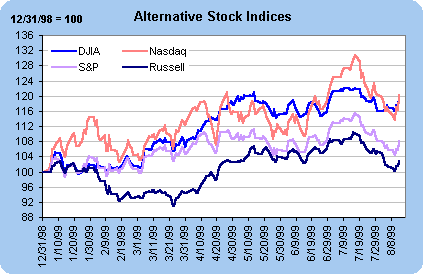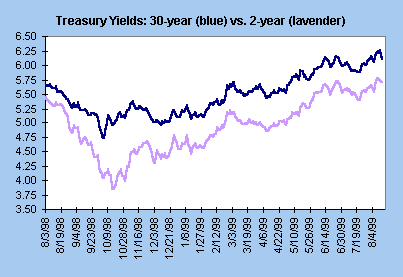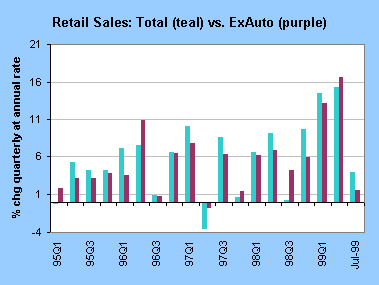Simply Economics August 13, 1999
By Evelina M. Tainer, Chief Economist
Friday the 13th turns out well for financial markets
Equity prices recover on good inflation news
While Friday the 13th is often feared due to old time superstitions, today's 13th brought good news to the financial markets. All market indices participated in the day's rally. In the past couple of days, the downward movement in the NASDAQ composite brought its year-to-date gain below the Dow momentarily. After the Friday rally, the NASDAQ retook its first place among the indices. The S&P 500 and the Russell 2000 continue to under-perform relative to the Dow and NASDAQ measures. Some analysts have claimed that the market is broadening its gains, but the broader indices still have a way to go to catch up with the Dow and the tech market.

Treasury prices curtailed by refunding, but PPI news saves the day
The Treasury market resumed its crazy pattern of up/down movement in prices and interest rates. The quarterly refunding caused supply indigestion as the bond market faced 5-year, 10-year and 30-year Treasury auctions. The friendly PPI news led to a market rally on Friday. The long bond yield surpassed the 6 ¼ percent level yesterday afternoon. By day's end, the yield had decreased more than 15 basis points.

|
Markets at a Glance |
| Treasury Securities | 12/31/98 | August 6 | August 13 | Weekly
Change |
|
30 year Bond | 5.09% | 6.17% | 6.10% | - 7 BP |
|
10 year Note | 4.65% | 6.03% | 5.97% | - 6 BP |
|
5 year Note | 4.53% | 5.90% | 5.87% | - 3 BP |
|
2 year Note | 4.53% | 5.67% | 5.70% | + 3 BP |
| Stock Prices |
|
Dow Jones Industrial Average | 9181* | 10714* | 10974 | + 2.4 % |
|
S&P 500 | 1229* | 1300* | 1328* | + 2.2 % |
|
NASDAQ Composite | 2193* | 2548* | 2638* | + 3.5 % |
|
Russell 2000 | 422* | 428* | 434* | + 1.4 % |
| Exchange Rates |
|
Euro/$ | 1.1668 | 1.0752 | 1.0564 | -1.7 % |
|
Yen/$ | 113.20 | 114.70 | 115.75 | + 0.9 % |
| Commodity Prices |
|
Crude Oil ($/barrel) | $12.05 | $20.88 | $21.67 | v+ 3.8 % |
|
Gold | $289.20 | $258.60 | $263.20 | + 1.8 % |
| (* rounded) - (BP = basis points; stock price indices are rounded) |
|
Producer price index remains quiescent
The producer price index increased 0.2 percent in July despite a 3.4 percent surge in energy prices. A 0.9 percent decline in food prices helped to curtail the overall gain. More importantly, the PPI excluding these two volatile components remained unchanged for the month. As indicated in the chart below, the PPI exhibited some acceleration in the past several months. Yet, it does appear that the index is once again moderating.

The inflation hawks may point to the PPI for intermediate and crude goods as indications of future inflationary pressures. The PPI for intermediate goods rose 0.6 percent - and even excluding food and energy, this index edged up 0.4 percent (its fifth straight monthly gain.) At the same time, the crude materials components edged down 0.2 percent as sharp declines in food prices offset gains elsewhere. Excluding food and energy, though, the crude materials index jumped 2.3 percent, its third consecutive monthly rise.
The PPI for intermediate and crude goods are consider leading indicators of price changes at the finished goods level. It has been our experience, however, that the indices usually move in tandem when price pressures are rampant. Producers don't always have pricing power and can't always pass along price increases at earlier stages of processing. That was last evident in 1996 and 1997. Crude materials prices surged, but finished goods prices increased modestly.
The bottom line on the PPI report? Crude materials prices are picking up (as evident in the daily commodity price indices), but this may not necessarily be translated into higher finished goods prices for consumers.
Headline retail sales masks potential slower trend
Retail sales increased 0.7 percent in July after a 0.2 percent dip in June. Excluding a spurt in autos, retail sales posted a more moderate gain of 0.3 percent. This included a 1.2 percent jump in sales at gasoline stations - which incorporates higher pump prices. It does appear that non-auto retail spending is going to a slower track. The chart below compares quarterly growth in retail sales (at annual rates) over the past few years. July is compared with the previous quarter levels. It suggests a sharp rise in retail sales would be necessary in August and September to keep sales at the heady pace of the first half of 1999. It may be signaling the moderation for which the Fed waits.

The bottom line on retail sales? One month doesn't make a trend, but it is possible that the consumer is headed towards a slower growth path. The Fed would be relieved to see smaller gains in retail sales. But don't count the consumer out entirely. After all, income growth is good and stock market is still booming.
THE BOTTOM LINE
Economic news dribbled in this past week. Market players mostly focused on the quarterly refunding auctions. For the most part, the auctions didn't get a great reception as bond market players worried about supply. The lack of real news also kept the equity market in the doldrums. The friendly inflation news spurred a market rally in the Treasury and equity markets on Friday morning.
The Fed's August FOMC meeting is fast approaching. The majority of market players expect that the Fed will raise the federal funds rate 25 basis points from 5 percent to 5.25 percent on August 24. In the past couple of weeks, market players have begun to fear that the Fed might go on an extended rate hike phase. Those fears were laid to rest on Friday morning with the subdued inflation news. This is not to say that investors won't become fearful again if strong economic figures persist in the next couple of months or inflation spurts.
Looking Ahead: Week of August 16 to 20
Few key economic indicators will be reported this week. We use the Market News Service survey of forecasts to describe the market consensus.
Tuesday
Market participants are looking for the consumer price index to increase 0.3 percent in July as the negative repercussion of surging energy prices. Excluding food and energy, the CPI should post a 0.2 percent hike. This would be slightly faster than the 0.1 percent gains reported in the past couple of months.
Housing starts are expected to rise 2.5 percent in July to a 1.61 million unit rate. This would recoup about half of the June drop. Higher mortgage rates will eventually hamper housing construction, but the initial impact of higher rates is to spur those potential buyers sitting on the fence. Housing permits should edge up 0.5 percent in July to a 1.65 million unit rate.
The market consensus calls for a 0.8 percent jump in industrial production in July. This reflects the improved picture in factory payrolls. If realized, this would be the largest monthly gain in industrial production since last August when the auto industry was recovering from the GM strike. This would boost the capacity utilization rate up to 80.7 percent in July.
Thursday
Market participants are expecting new jobless claims to rise 6,000 in the week ended August 14 from last week's 284,000. The number of economists predicting this indicator has diminished rapidly these past couple of months as its volatility has increased.
The international trade deficit on goods and services should improve marginally in June with a deficit of $20.5 billion compared with a $21.3 billion shortfall in May. This would come from a moderate gain in exports coupled with a drop in imports.
The market consensus shows a slight rise in the Philadelphia Fed's business outlook survey to 10 in August from 7.8 in July. This corresponds with the improved industrial production outlook.
Friday
Economists are predicting the federal budget will post a $24 billion deficit in July. This is in line with deficits recorded for this month over the past few years.
|





